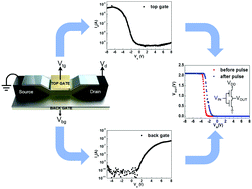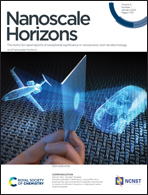Polarity-controllable MoS2 transistor for adjustable complementary logic inverter applications†
Abstract
In this work, we introduce a MoS2-based field effect transistor that can alternately operate either as a p-type or an n-type semiconductor in the same device. The proposed device is built with an adjustable threshold voltage (Vth), which can be varied by adding a layer of plasma-oxidized dielectric at the top gate structure. This facilitates a surplus of oxygen due to the relatively thin grown dielectric layer and the creation of negative charges in that layer instead of the usual ones of positive polarization in the bottom dielectric layer. Consequently, the Vth shifts and the top gate structure switches from the typical n-type to p-type while the n-type behaviour remains in the application of the bottom-gate voltages. The Vth can be tuned further by applying a gate pulse input at the top gate. Accordingly, we have demonstrated complementary logic inverters with adjustable device characteristics that are controllable by the polarity of charges induced in the device's oxide layer. This is a big step towards the concurrent implementation of both n-type and p-type characteristics in a single device.



 Please wait while we load your content...
Please wait while we load your content...